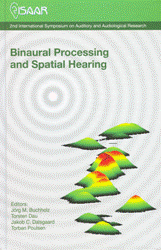Speech perception with combined electric acoustic stimulation (EAS) and bilateral cochlear implant in a multi source noise field
Abstract
Objective: Combined electric acoustic stimulation (EAS) is a therapeutic option for patients with severe-to-profound high and mid frequency hearing loss but remaining low frequency hearing. The present study applied a multi-source noise eld (MSNF), consisting of a four-loudspeaker array with independent noise sources, in combination with a closed set sentence test (Oldenburger Sentence Test, OLSA) to measure and compare speech perception in noise in EAS and bilateral cochlear implant (CI) subjects. Speech simulating noise (Fastl-Noise) as well as CCITT-noise (continuous) and OLSA-noise (pseudo continuous) served as noise sources with different temporal pattern. Speech tests were performed in two groups of patients aided in either the EAS condition (n=7) or with bilateral cochlear implant (n=10). All subjects in the EAS group were tted with a high power hearing aid in the opposite ear. A group of 20 normal hearing listeners served as controls. Results: Speech reception thresholds (SRT) were severely compromised by modulated (Fastl)- noise in both groups of cochlear implant listeners compared to normal hearing listeners. Average EAS subject group SRTs were lower than average results of the bilateral CI group in all noise conditions. In reference to the OLSA-noise condition, the EAS group data showed better SRTs especially in the Fastl- noise condition. The overall better performance in modulated noise conditions in the EAS group might be explained by 1) “glimpsing”, the enhanced ability of the residual acoustic hearing to listen into temporal gaps or 2) improved transmission of fundamental frequency cues in the lower frequency region of acoustic hearing, which might foster grouping of speech auditory objects. Furthermore, the results do indicate, that binaural interaction between EAS implanted ear and residual acoustic hearing in the opposite ear enhances speech perception in complex noise situations.
References
Dorman, M. F., Gifford, R. H., Spahr, A. J., and McKarns, S. A. (2008). “The bene ts of combining acoustic and electric stimulation for the recognition of speech, voice and melodies,” Audiol Neurootol. 13, 105-112.
Fastl, H., Oberdanner, H., Schmidt, W., Stemplinger, I., Hochmair-Desoyer, I., and Hochmair, E. (1998). “Zum Sprachverständnis von Cochlea-Implantat-Patienten bei Störgeräuschen, ” in Fortschritte der Akustik - DAGA ‘98, edited by A. Sill (Oldenburg, DEGA e.V.), pp. 358-359.
Fastl, H. (1987). “Ein Störgeräusch für die Sprachaudiometrie,” Audiol. Akustik 26, 2-13.
Gstoettner, W., Helbig, S., Settevendemie, C., Baumann, U., Wagenblast, J., and Arnoldner, C. (2009). “A new electrode for residual hearing preservation in cochlear implantation: rst clinical results,” Acta Otolaryngol. 129, 372-379.
Helbig, S., Baumann, U., Helbig, M., von Malsen-Waldkirch, N., and Gstoettner, W. (2008). “A New Combined Speech Processor for Electric and Acoustic Stimulation - Eight Months Experience,” Orl-Journal for Oto-Rhino-Laryngology and Its Related Specialties 70, 359-365.
Kiefer, J., Tillein, J., von Illberg, C., Pfennigdorff, T., Stürzebecher, E., Klinke, R., and Gstöttner, W. (2002). “Fundamental aspects and rst clinical results of the clinical application of combined electric and acoustic stimulation of the auditory system,” in Advances in Cochlear implants – Un Update, edited by T. Kubo, T. Iwaki, and Y. Takagashi (The Hague, Kugler Publications), pp. 569-576.
Rader, T., Schmiegelow, Ch., Baumann, U., and Fastl, H. (2008). “Oldenburger Satztest im “Multi-Source Noise Field” mit unterschiedlichen Modulationscharakteristika,” in Fortschritte der Akustik - DAGA ‘08, (Oldenburg, DEGA), pp. 663-664.
Von Ilberg, C., Kiefer, J., Tillein, J., Pfenningdorff, T., Hartmann, R., Sturzebecher, E., and Klinke, R. (1999). “Electric-acoustic stimulation of the auditory system - New technology for severe hearing loss,” ORL J Otorhinolaryngol Relat Spec. 61, 334-340.
Wagener, K., Kollmeier, B., and Kühnel, V. (1999). “Entwicklung und Evaluation eines Satztests in deutscher Sprache I: Design des Oldenburger Satztests,” [Development and evaluation of a set test in German language I: Design of the Oldenburger set test], Z. f. Audiol. 38, 4-15.
Wagener, K. C., Brand, T., and Kollmeier, B. (2006). “The role of silent intervals for sentence intelligibility in uctuating noise in hearing-impaired listeners,” Int. J. Audiol 45, 26-33.
Additional Files
Published
How to Cite
Issue
Section
License
Authors who publish with this journal agree to the following terms:
a. Authors retain copyright* and grant the journal right of first publication with the work simultaneously licensed under a Creative Commons Attribution License that allows others to share the work with an acknowledgement of the work's authorship and initial publication in this journal.
b. Authors are able to enter into separate, additional contractual arrangements for the non-exclusive distribution of the journal's published version of the work (e.g., post it to an institutional repository or publish it in a book), with an acknowledgement of its initial publication in this journal.
c. Authors are permitted and encouraged to post their work online (e.g., in institutional repositories or on their website) prior to and during the submission process, as it can lead to productive exchanges, as well as earlier and greater citation of published work (See The Effect of Open Access).
*From the 2017 issue onward. The Danavox Jubilee Foundation owns the copyright of all articles published in the 1969-2015 issues. However, authors are still allowed to share the work with an acknowledgement of the work's authorship and initial publication in this journal.


